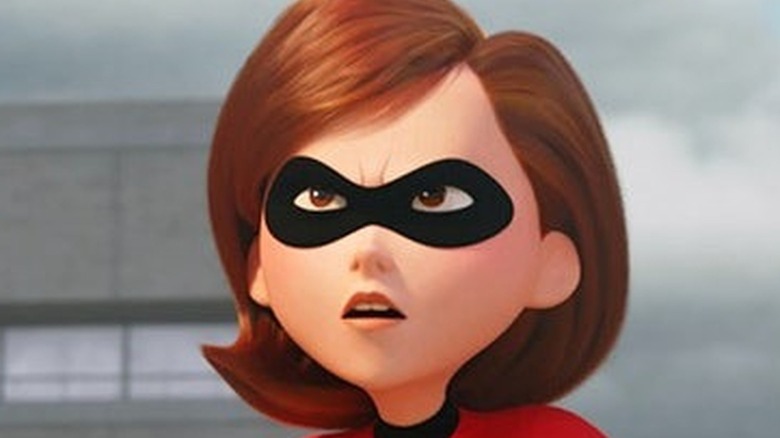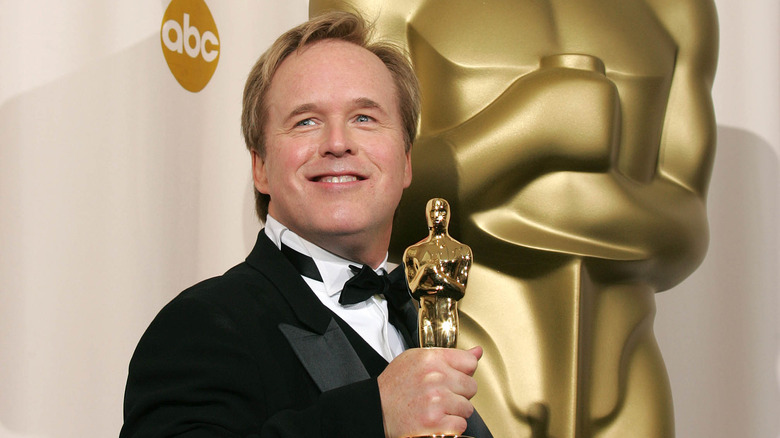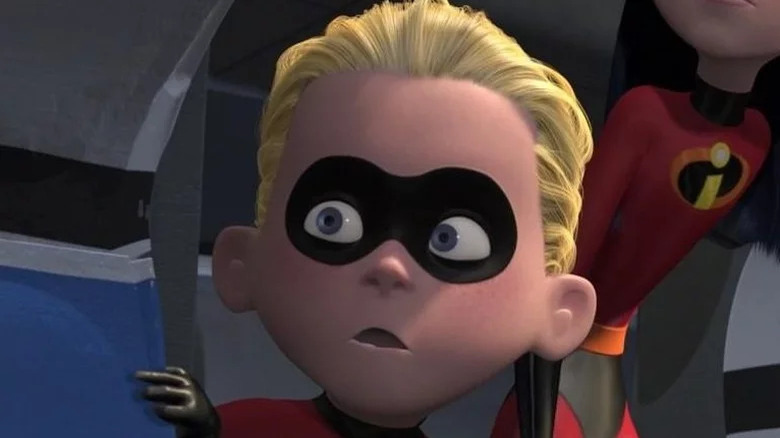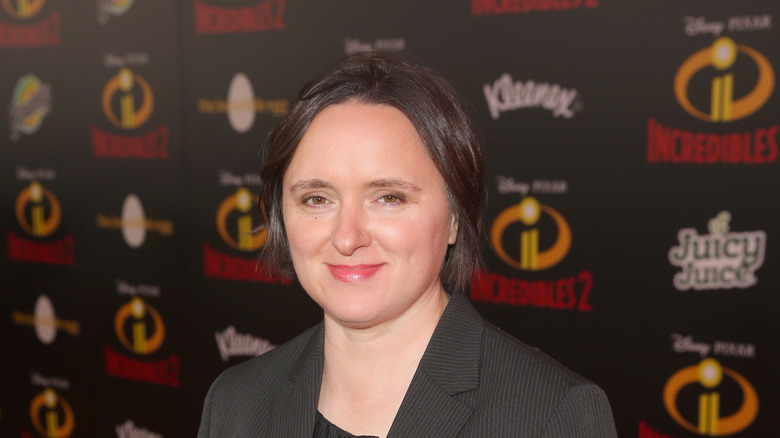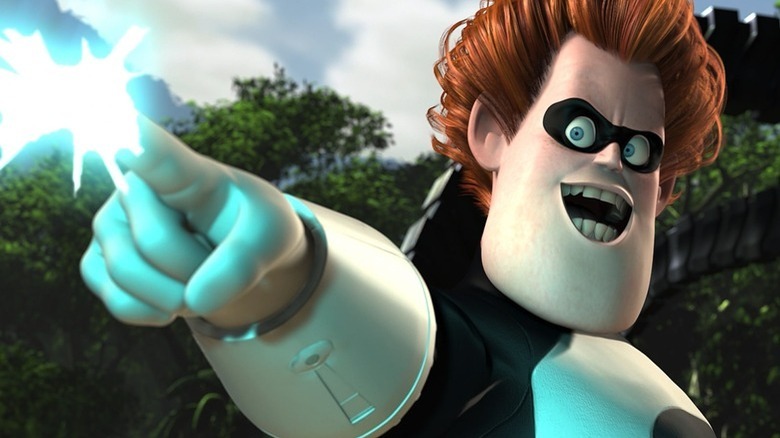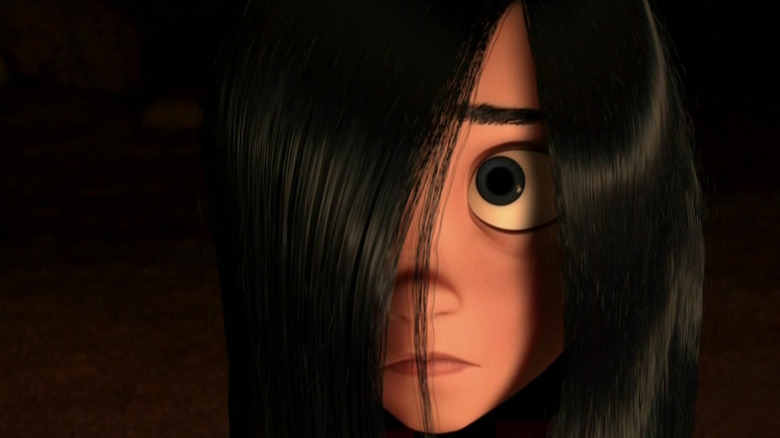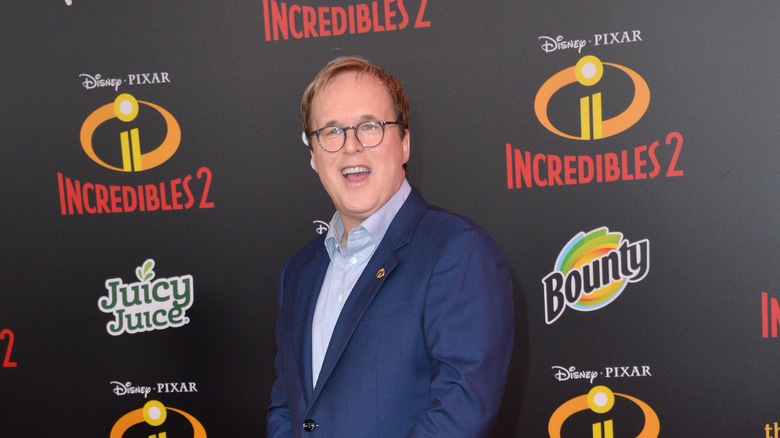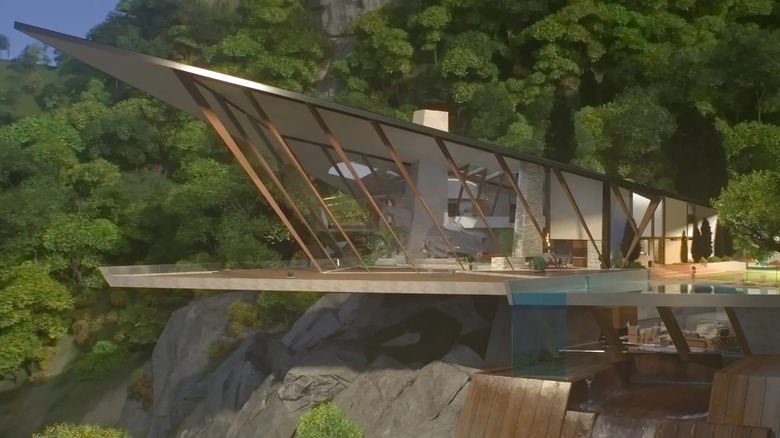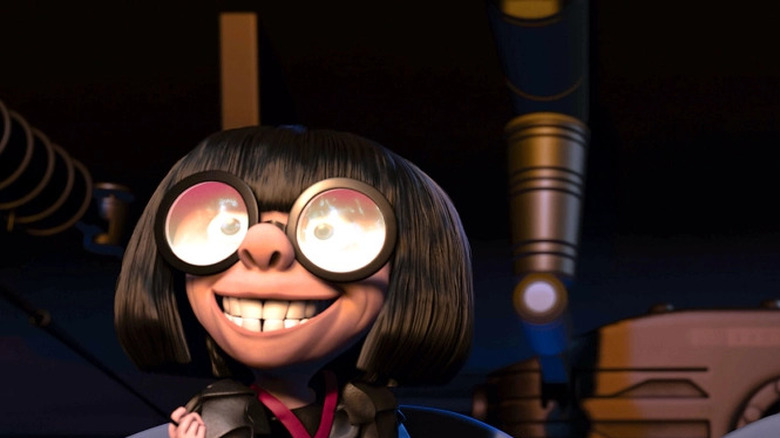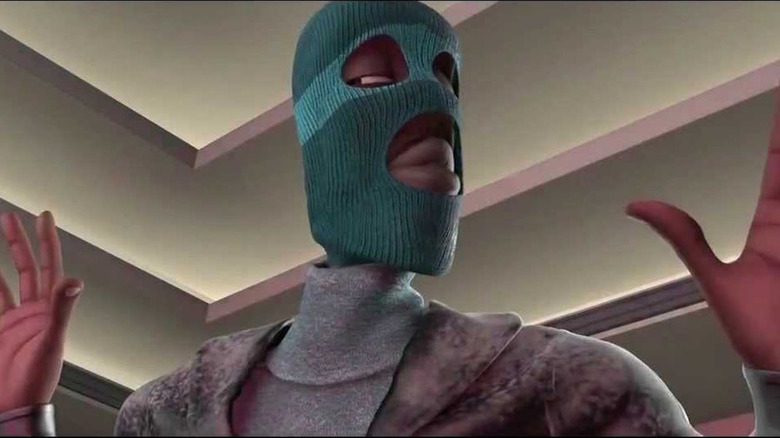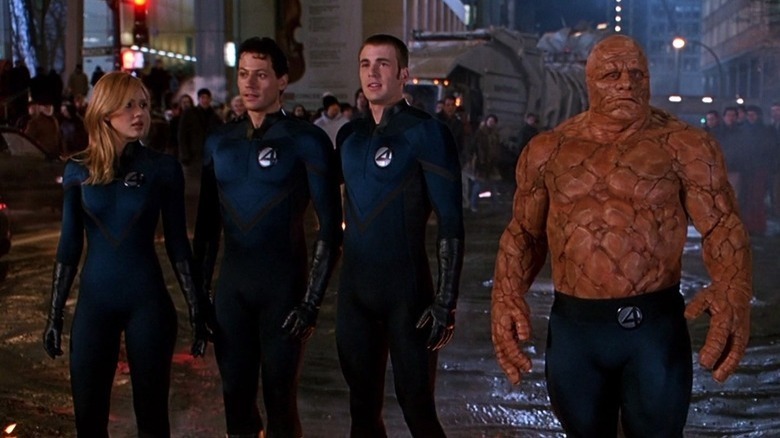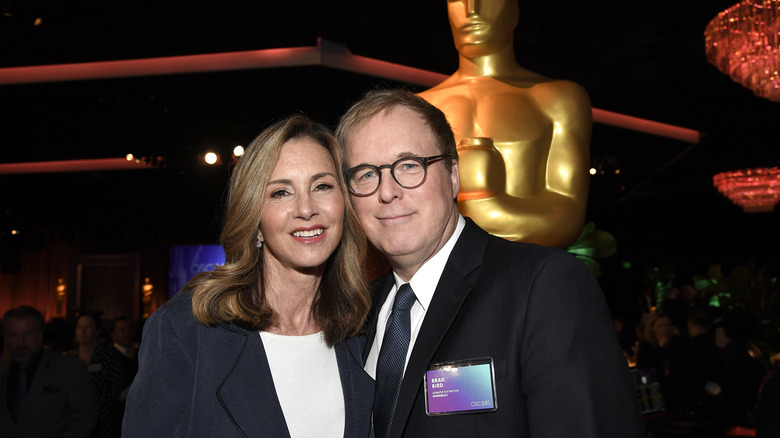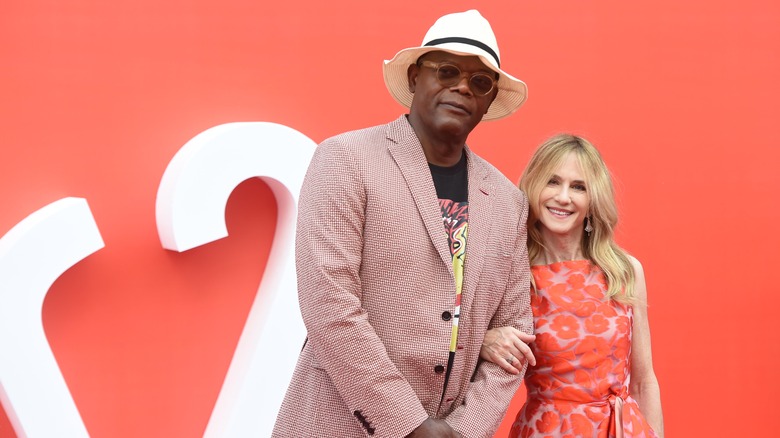The Untold Truth Of Pixar's The Incredibles
Before the Marvel Cinematic Universe had emerged, before the Justice League had made their big-screen debut, there was another superhero supergroup who captivated cinema audiences.
In 2004, Pixar released "The Incredibles," the groundbreaking company's first feature film to star human characters. Directed by Brad Bird, primarily known at the time as the man behind "The Iron Giant," "The Incredibles" followed an all-American family of superheroes. After the government bans superheroes, Mr. Incredible (Craig T. Nelson) and Elastagirl (Holly Hunter) are forced to settle down in the suburbs with their kids. When Mr. Incredible gets the opportunity to fight the bad guys again he jumps at the chance, but when he runs into trouble, only his super-powered family can save him.
"The Incredibles" was hugely successful, making more than $600 million worldwide and earning two Oscars. The sequel, which came out 14 years after the original film, went on to become the highest-grossing Pixar film of all time, making over $1 billion at the international box office. It's safe to say that "The Incredibles" became something of a phenomenon. The world's most famous superhero family (well, perhaps until Marvel finally gets around to making that "Fantastic 4" film), their cultural imprint has been impressive.
But even huge sensations can have humble origins — with an idea, or a dream perhaps. So how did "The Incredibles" come about? And what kind of work went into making this story a global phenomenon? Keep reading to find out all the things you never knew about "The Incredibles."
It wasn't inspired by comic books
Yes, the concept of a superhero family would seen to have "Fantastic 4" written all over it, and the notion of banned superheroes in hiding undoubtedly owes a lot to "Watchmen," right?
Considering its subject matter, one might assume that the creator of "The Incredibles" is a fan of comic books; that is not the case. Speaking with animation historian Michael Barrier in 2005, writer/director Brad Bird said he didn't grow up reading superhero comics, despite what many fans have assumed. While some have been able to draw connections between "The Incredibles" and various comic book superheroes, Bird says it's not the super-heroed aspects of the film that are really interesting to him.
"The part that I'm interested in is all the personal stuff," he told Barrier. "I tried to base the powers on family archetypes. The father is always expected to be strong, so I had him have strength. Moms are always pulled in a million different directions, so I had her be elastic," Bird explained. The same goes for the Parr children as well. "Teenagers are insecure and defensive, so I had her be invisible and have protective shields. Ten-year-old boys are hyperactive energy balls, so I had him be speed. And babies are unknown — they may have great powers, they may have none."
Though their powers are very real, they're also purposefully analogous to the roles each family member plays. But Bird admits that his superpower ideas aren't exactly original, even if he didn't explicitly base them on comic book characters. "I'd be astonished if anyone could come up with any truly original powers that were at all interesting anymore," he said.
The actor who voiced Dash prepared for the role in a unique way
Voice acting isn't something that gets talked about much, and for that reason, some of the most prolific voice actors in Hollywood aren't household names. For example, most people probably don't know the name of the actor who voiced Dash in the first "Incredibles." Since you asked, we'll tell you: his name is Spencer Fox, and he happens to have switched career paths since his role in "The Incredibles." Fox is now part of an indie-pop band called Charly Bliss, though he would have been too old to voice Dash in "The Incredibles 2" anyways.
Speaking with Track Record in 2018, Fox discussed his role in "The Incredibles" and revealed one of the interesting ways he prepared for the part. Unsurprisingly, "The Incredibles" required cast members, especially Fox, to make a lot of grunting and groaning noises to go along with their super-powered antics. Fox's character, Dash, is frequently seen running, which provided a unique challenge for Fox.
Fox says that during the scene when Dash is running through the jungle, "Brad Bird had me run four laps around the entire Pixar Studios so I could sound accurately out of breath." While this sounds mildly tortuous, Fox maintains that it was actually very fun. Bird apparently jogged the first lap around the studio with Fox, and by the time he got back to the recording booth, he was "truthfully out of breath."
Violet was cast because of a radio appearance
We've all heard stories of actors being cast off the street, but have you ever heard of someone being cast from the radio? For director Brad Bird, that's just what happened with Violet, the elusive teenager in "The Incredibles." At the time the film was being made, Sarah Vowell, the voice of Violet, was a regular contributor to This American Life. Vowell is a writer and journalist by trade, and has written several books on American history and contemporary culture.
When Bird heard Vowell on the radio, he knew he had to cast her. One friend described Vowell's voice as "equal parts Betty Boop and Dorothy Parker," and her unique vocal quality makes her sound like a teenager. As Vowell told The Independent, it's not uncommon for her to get offers from Hollywood due to her work in radio, but she usually turns these offers down. But when she got the offer from Brad Bird and Pixar, she decided she couldn't say no. She was impressed at what they were doing with animation and the seriousness with which they took the craft.
"They made such decisions to amuse themselves, but also with the hope that extra meaning could be communicated on a more subliminal level. That's why I said yes to entertaining the thought of acting, of doing something I had never done before." Who knew there was a connection between public radio and an animated, superpowered teenager?
Syndrome originally wasn't the villain
A good villain is an essential element in creating a successful superhero movie. In "The Incredibles," the main villain is an evil mastermind known as Syndrome, voiced by Jason Lee. Also known as Buddy Pine, Syndrome was Mr. Incredible's biggest fan until Mr. Incredible turned down his offer to be a sidekick. He grew up to become a successful weapons designer with a plot to wreak vengeance on Mr. Incredible and his family.
In an early script for the film, Syndrome wasn't meant to be a villain at all, and he only had a small part in the film. The original villain was a character named Xerek, a foe who was inspired by the James Bond villains of the 1960s. As the story went, Xerek was an old boyfriend of Elastagirl who was jealous of Mr. Incredible. Information about Xerek was included in the bonus features for the film, and early concept art was revealed in the book "The Art Of The Incredibles."
The production team also had a fun time animating Syndrome, as Bird tells it. Speaking with NPR, Bird revealed that the animators had actually constructed Syndrome to look like Bird himself. Bird didn't realize what was happening until it was too late to change it, and though he maintains that he doesn't look like Syndrome at all, now you know the truth.
Violet's hair was the most difficult thing to animate
Moviegoers take it for granted now, but human beings are incredibly hard to animate. This might explain why it took Pixar nearly a decade to make a feature film that exclusively starred humans. Unsurprisingly, "The Incredibles" was quite difficult to animate, especially because animation technology wasn't as advanced 20 years ago as it is today. Most of Bird's team also went from working in 2D animation to CGI, an adjustment that took them a while to master.
According to the cast and crew, out of all the challenges they had during production, there was one thing that gave them the fits: Violet's hair. It was extremely important to the story that the Incredibles' daughter have long hair — she's very shy and frequently hides behind it — so animators knew they couldn't compromise on that. "They started asking me, 'Does she need to have long hair?'" Bird told the New York Times. "And I said, yes! That's her character arc!"
Because Violet's hair is so long, it moves when she moves, and it has no fixed placement or style. According to technical director Rick Sayre, this was incredibly difficult for the team. "This is one of those cases where she was impossible when we started the film. I mean, actually impossible until stomach-churningly, terrifyingly late in production," Sayre said. Sarah Vowell, who voiced Violet, noted that for most of the production Violet was bald, and that animators kept saying "the hair is still theoretical."
Brad Bird was hesitant to make a sequel
Fourteen years is a long time to wait between movies, even by Pixar standards. In fact, the gap between "The Incredibles" and "The Incredibles 2" is the longest gap between sequels in the studio's history, edging out "Finding Nemo" and "Finding Dory" by several months. According to director Brad Bird, there was a good reason.
As Bird told IGN in 2018, he was hesitant to make a sequel to "The Incredibles" because it seems so many sequels are "cash grabs" these days. Bird said he only wanted to make "The Incredibles 2" when he had a good story in mind, which happened to be 14 years after the fact.
The only problem with this extended gap is that the film and television landscape has changed significantly since the first film's release, as superheroes have now populated almost every aspect of pop culture. As Bird put it, "not only do you have every superhero under the sun and cross-promoting films and blah blah blah blah blah, but you also have a bunch of television shows ... So it's easy to freak out and go, well, why even try?"
Luckily, Bird and his team did make an attempt. As Bird said, "I return to, what makes us unique? And it's this idea of a family, and that superheroes have to hide their abilities [from the public, due to Superhero Relocation Program]. And those things are actually unique to us, and there's plenty left to explore."
The family having a larger home was an important part of the sequel
There were a number of changes made from "The Incredibles" to "The Incredibles 2," many of them having to do with technological advancements that developed in the gap between the two films. One of these changes was both a technical consideration and a story one.
At the end of the first "Incredibles" film, the Parr family home was destroyed. This meant that no matter what, they needed a new house for the sequel. In "The Incredibles 2," The Parr family is gifted a mansion to live in by a tech tycoon who wants to make the family into famous superheroes again. Their new home sits above a waterfall and has a distinctly modern style, wall-to-ceiling windows included.
Though the team knew they needed a new house, the one in the film wasn't their initial idea. The original house that they created for the film was around 2,300 square feet, while the final house came out to around 20,000 square feet. The idea for a larger house had been pitched early on in the process, but it wasn't until the script was being written that it was decided on. "What happened was, at a certain point while Brad [Bird] was writing, he had to consolidate a number of sequences into one ... then I pitched the idea of the larger house again and something clicked," Production Designer Ralph Eggleston recalled in 2018.
As for the design of the house, it was inspired by mid-century architects like Frank Lloyd Wright, and the production team traveled to Palm Springs to get inspired by houses built in that era.
Lily Tomlin was offered the role of Edna Mode
Edna Mode is one of the most beloved characters in "The Incredibles" films, and she is also one of the most quotable. (How often have you been watching a superhero movie and thought of Edna yelling "no capes"?) But while her voice and mannerisms have become cemented in pop culture, the story behind her character might surprise you.
Edna was always going to be an iconic character, so it's no surprise director Brad Bird had at least one iconic actress in mind for the part. He initially approached Lily Tomlin — who, among her many accolades in film and television, is also known for voicing Ms. Frizzle from "The Magic School Bus" — but she turned him down. According to the NY Post, he recorded the dialogue for her into a tape recorder so she could listen to it and get a sense of the character. Tomlin apparently liked Bird's approach to the character so much that she declined to take the role, suggesting that Bird voice the character himself.
Bird might seem like an unusual choice for the voice of the tiny fashion maven, but he claims that there are certain times when he relates to her. "At my most confident, I feel like her," Bird said. "She is absolutely convinced that her way is the right way, and if you disagree ... you're just wrong!"
'The Incredibles' has a 'Die Hard' reference
Fans tend to love finding easter eggs in their favorite films, and Pixar is well aware of this. From the Pizza Planet truck to the extensive Pixar Timeline Theory proposed by John Negroni, the creatives at Pixar are famously clever.
In "The Incredibles," there's one Easter egg that was clearly made for the adults in the audience. In case you didn't know, the character of Frozone, Mr. Incredible's friend and a superhero in his own right, is voiced by Samuel L. Jackson, a screen legend and the highest-grossing actor in Hollywood. One of the many films on Jacksons' resume is "Die Hard: With a Vengeance," the third film in the "Die Hard" franchise.
One famous scene in "Die Hard" sees Jackson's character, Zeus, attempting to answer a payphone to stop a bomb from going off. Zeus harasses the person using the payphone until he leaves, which leads to a confrontation with a cop. The cop nervously points the gun at Zeus while he calmly says "I have to answer that phone."
The scene in "The Incredibles" is very similar, though it happens under different circumstances. When Frozone and Mr. Incredible show up to stop a robbery, they're caught by police who think they've committed the crime themselves. With guns trained on them, Frozone slowly, calmly says "I'm just getting a drink," inching towards the water cooler so he can re-up his powers. Not only is the situation similar, but Jackson says the line in a similar cadence as in "Die Hard," and the blonde, sweaty cop looks the same as well. Still don't believe it? You can watch a side-by-side here.
The film made the producers of Fantastic Four nervous
These days it might not seem like a big deal for two superhero movies to come out around the same time, but this situation wasn't as common in the early 2000s. So, while "The Incredibles" still feels like it stands alone within the superhero genre, there were some movie producers who were threatened by its success and technical prowess.
"The Incredibles" created huge waves when it came out in 2004, but another film, which came out the following year, wasn't quite as successful. Before The Avengers and The Justice League graced screens, there was "The Fantastic Four." Though it did fairly well at the box office, it was dunked on by most critics, as was the sequel. (Even worse was the ill-advised reboot from 2015.)
While it may seem odd at first glance, the producers of "The Fantastic Four" were actually worried about how good "The Incredibles" looked and the fact that audiences might compare the two movies. They're actually quite similar if you think about it. In fact, three of the superpowers are the same: super-strength, invisibility, and elasticity.
Director Tim Story has said they only changed "about one percent" of the movie due to "The Incredibles," but it was also reported back in 2004 that "the entire third act of 'Fantastic Four' has undergone extensive changes as a result" of the film. The report went on to say that once the team saw Elastagirl's stretching effects in "The Incredibles” they decided the action surrounding Mister Fantastic needed to be "beefed up." It's clear which of the two movies won this superhero battle, though you can't blame Story and his team for trying to make their mark.
Brad Bird was told it was an unmakeable movie
People often forget how difficult animation is, and it was even more difficult 20 years ago when "The Incredibles" first began production. Not only was the film Pixar's first human-only film, but it also contained a lot of action and effects that most animators at the time had simply never done.
In a 2005 interview, director Brad Bird spoke to IGN about how he was told "The Incredibles" was an "unmakeable movie" when he first pitched it to Pixar. According to Bird, he was told it was "Just way too complicated, too many characters, too many costume changes, too many effects, too many locations, too many sets. If we had done the humans the way Pixar had done them prior to this, it would have taken four years just to build the characters."
Because they were essentially breaking new ground with this film, they "had to invent a whole new way to build [humans]," Bird said. "We were told it would take ten years and cost a gazillion dollars by people here who are very smart." Bird went on to say that, whether it be CGI or hand-drawn animation, humans are the hardest to animate "because everybody has a feeling for how they move." It's hard to animate them in any situation, but portraying complex emotions like pain and regret is even more difficult, Bird said. Clearly, the filmmaker and his team knew what they were doing, as the animation in "The Incredibles" still looks great after all these years.
None of the voice actors were in the studio together
Voice acting may sound seamless when you hear it on screen, but the reality of the job is actually a bit odd. Holly Hunter, who voices Elastagirl, revealed that all the actors in the film recorded their parts separately, and never saw each other during the recording process.
"We all recorded the first movie with Brad, and only with Brad, not with one another, and Brad would play all the other characters and then we would record with him and then he would give us direction," Hunter told Digital Spy in 2018.
Clearly Bird's strategy worked — in fact, IndieWire rated Hunter's performance in the film the third-best voice performance in any Pixar film. For Hunter, who had never done an animated film before, the strangest part was not during recording, but seeing the film after the fact.
"It was a total shock to see the movie," she explained. "Frankly, I was not prepared for that."
